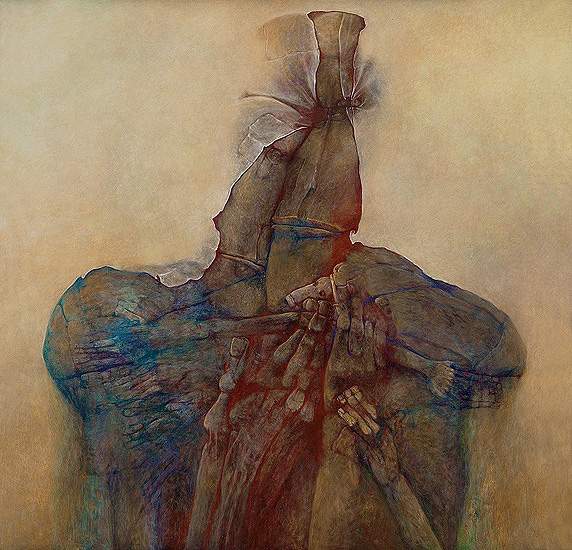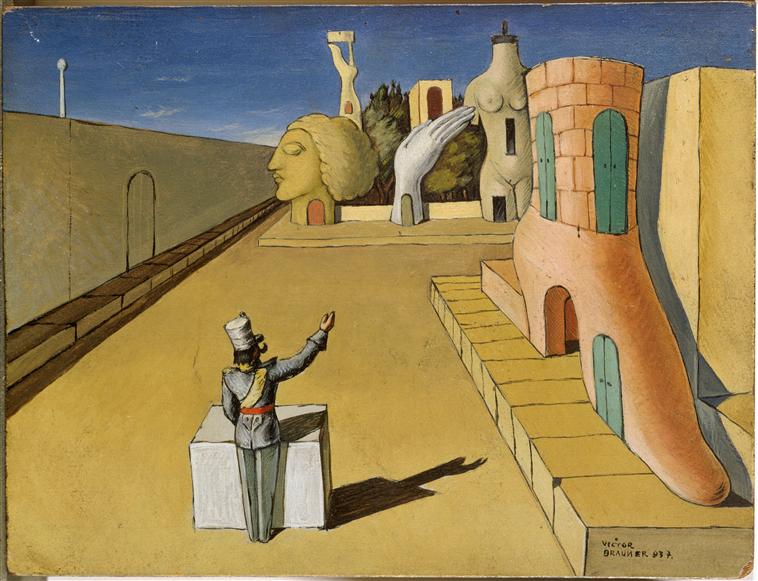‘I miss TV,’ Orin said, looking back down. He no longer smiled coolly.
‘The former television of commercial broadcast.’
‘I do.’
‘Reason in several words or less, please, for the box after REASON,’ displaying the board.
‘Oh, man.’ Orin looked back up and away at what seemed to be nothing, feeling at his jaw around the retromandibular’s much tinier and more vulnerable throb. ‘Some of this may sound stupid. I miss commercials that were louder than the programs. I miss the phrases “Order before midnight tonight” and “Save up to fifty percent and more.” I miss being told things were filmed before a live studio audience. I miss late-night anthems and shots of flags and fighter jets and leathery-faced Indian chiefs crying at litter. I miss “Sermonette” and “Evensong” and test patterns and being told how many megahertz something’s transmitter was broadcasting at.’ He felt his face. ‘I miss sneering at something I love. How we used to love to gather in the checker-tiled kitchen in front of the old boxy cathode-ray Sony whose reception was sensitive to airplanes and sneer at the commercial vapidity of broadcast stuff.’
‘Vapid ditty,’ pretending to notate.
‘I miss stuff so low-denominator I could watch and know in advance what people were going to say.’
‘Emotions of mastery and control and superiority. And pleasure.’
‘You can say that again, boy. I miss summer reruns. I miss reruns hastily inserted to fill the intervals of writers’ strikes, Actors’ Guild strikes. I miss Jeannie, Samantha, Sam and Diane, Gilligan, Hawkeye, Hazel, Jed, all the syndicated airwave-haunters. You know? I miss seeing the same things over and over again.’ …
The man tended to look up at him like people with legs look up at buildings and planes. ‘You can of course view entertainments again and again without surcease on TelEntertainment disks of storage and retrieval.’
Orin’s way of looking up as he remembered was nothing like the seated guy’s way of looking up. ‘But not the same. The choice, see. It ruins it somehow. With television you were subjected to repetition. The familiarity was inflicted. Different now.’
‘Inflicted.’
‘I don’t think I exactly know,’ Orin said, suddenly dimly stunned and sad inside. The terrible sense as in dreams of something vital you’ve forgotten to do. The inclined head’s bald spot was freckled and tan. ‘Is there a next item?’
—From David Foster Wallace’s novel Infinite Jest (1996).
Perception, Plato said, is a form of pain.
The working consciousness, for instance, is narrow, shuttered by utility, its transitions eased by habit past reflection like a thief. Impulses from without or from within must use some strength to reach us, we do not go out to them. Machines are made this way. Alert as lights and aimed like guns, they only see the circle of their barrels. How round the world is; how like a well arranged. Thus when desire is at an ebb and will is weak, we trail the entertainer like a child his mother, restless, bored and whining: what can I do? what will amuse me? how shall I live? Then
L’ennui, fruit de la morne incuriosite,
Prend les proportions de l’immortalite.
The enjoyment of sensation as sensation, a fully free awareness, is very rare. We keep our noses down like dogs to sniff our signs. Experience must mean. The content of an aimless consciousness is weak and colorless; we may be filled up by ourselves instead—even flooded basements, some days, leak the other way—and then it’s dread we feel, anxiety.
To tie experience to a task, to seek significance in everything, to take and never to receive, to keep, like the lighter boxer, moving, bob and weave, to fear the appearance of the self and every inwardness: these are such universal characteristics of the average consciousness that I think we can assume that popular culture functions fundamentally with regard to them.
—From William H. Gass’s essay “Even if, by All the Oxen in the World.” (1968). Collected in Fiction and the Figures of Life. The lines of verse are from Baudelaire, which I suppose is a third citation, no?
The very short note:
So I read Gass’s essay almost immediately after reading the section of Infinite Jest cited above, and now I can’t help but think of Wallace’s novel as a long digressive indirect response to Gass’s polemic on popular culture. Which of course is a radical reduction, but hey let’s leave that aside for a moment. Wallace conflates entertainment—particularly what Dwight Macdonald called “masscult”entertainment—with drugs and alcohol as two measures we use to “be drunk or doped or mad…dunced and numb” to our “completely aware” selves, to cite Gass again. In his essay Gass makes the same comparison (to opium, first, and then alcohol), before just laying it out as sharp as possible:
…popular culture is the product of an industrial machine which makes baubles to amuse the savages while missionaries steal their souls and merchants steal their money.
(So I’m over the two citations promised in this post’s title, and not sure how very short this very short note is, but).
Gass concludes his essay by pointing out that “none of his complaints are new,” but he reiterates that “This muck” — popular culture — “cripples consciousness.”
If Gass’s diagnosis was accurate, then let’s say little Dave Wallace, probably like in first grade when Gass’s essay was published, let’s say little Dave Wallace’s consciousness was mapped in that muck (cf. Orin’s nostalgia for TV above; cf. so much of Infinite Jest that I’ll broadly refer to here). And because he was mapped in that muck, consciousness-wise, Wallace attempts to reconcile pop culture in a way that Gass refuses to—like, Wallace has to—because the muck is quickly saturating culture, by the time that little Dave Wallace is old enough to cipher but probably not understand the words in Gass’s “Oxen.” (Please do not think I’m suggesting little Dave Wallace read Gass’s essay when little Dave Wallace (LDW?) was in first grade. I just enjoy the image). The muck inflicts consciousness, to borrow Orin’s verb.
And then me—how could I not come back to me myself me? narcissist that I am, borderline Gen X/Millennial that I am, raised in and on and through popular culture, pop cult masscult commercial cult — the military-industrial-entertainment complex that Pynchon warned us about—and then me, when I went to school, to college, to the college of liberal arts, there in the late nineties, what did I study? The English department was ruled by what they call the popular culture studies. So it was all muck, and the stuff that Gass would call art (or Art) was to be mucked or mediated or interpreted or understood through popular culture.
Which is what I mean to say is that:
And then now—when our Conversation, our Chatter—is all mucked through the muck, through pop culture, just popping popping always pop and chatter—when conglomerated concerns produce Mass Entertainments which we use for the platform, the material, the muck for Our Conversation on all the meaningful mulling matters that mean and matter and mull. And that I find myself often peering through a How-the-hell-did-we-get-here? lens when I tune in to chatter that raves against the dying of some character on a popular culture entertainment, or when yet another headline promises to tell me why some television show’s take on something matters so goddamn much.
And yet but still also—I mean, this is Wallace’s big insight in Infinite Jest, right?—that our consciousnesses, mapped in the muck, are framed in desire and reward, and we are conditioned/subjected into that system of desire/reward, so that we desire the desire, even as our consciousnesses, like Orin above, can sneer at something we love, can dismiss the muck that helped shape us even as we plunge into it, the muck. And—too, part of Wallace’s insight in Infinite Jest—too, the consciousness of the consciousness of the desire of desire—that that’s, like, the contemporary condition. And what Wallace seems to posit, or maybe I’m just way off here, but through all the AA stuff, and Mario Incandenza (who can’t feel pain, people!), what Wallace seems to want to point to is some way out of the muck of pop consciousness, a reconciliation toward a pure consciousness that doesn’t sneer—right?
Last note: Bad Baudelaire (mis)translation. Mea culpa (for all of this, really. These are notes for something more coherent, maybe):
Boredom, the fruit of dismal apathy,
Takes the shape of infinity.
Tagged: Consciousness, Culture, David Foster Wallace, Infinite Jest, Masscult, popular culture, rants, riffs, William H. Gass







.jpg)

 One satirical reading rule for True Detective Season 2 is introduced in the first episode, “The Western Book of the Dead.” In one of
One satirical reading rule for True Detective Season 2 is introduced in the first episode, “The Western Book of the Dead.” In one of  And the plot? What? Another reading rule, indulge me, indulge me, comes in the series’ overuse of aerial shots of L.A. freeways—big converging loops, sometimes black white gray, but often glowing lurid neon at night. The plot is easy to write off as a shaggy dog mess (see also Inherent Vice, Twin Peaks, The Big Lebowski), but it’s not. It does fit together (just like the plots of those examples I proffered parenthetically).
And the plot? What? Another reading rule, indulge me, indulge me, comes in the series’ overuse of aerial shots of L.A. freeways—big converging loops, sometimes black white gray, but often glowing lurid neon at night. The plot is easy to write off as a shaggy dog mess (see also Inherent Vice, Twin Peaks, The Big Lebowski), but it’s not. It does fit together (just like the plots of those examples I proffered parenthetically). 
 ET: The cover is great—spine too. I agree with you that it’s “quiet”—although that’s a strange word, y’know, considering there’s so much going on there—so much text. But the book is handsome, and the cover presents as a baseline postmodern conundrum—
ET: The cover is great—spine too. I agree with you that it’s “quiet”—although that’s a strange word, y’know, considering there’s so much going on there—so much text. But the book is handsome, and the cover presents as a baseline postmodern conundrum—




















 The book ends in 2015; I’ll let Mahé’s image speak for itself:
The book ends in 2015; I’ll let Mahé’s image speak for itself:








 As in the strips from eighties, the punchlines in The Bus 2 often pivot on our expectations, our perceptions, our subtle, unexamined prejudices. Kirchner often asks us to see that we don’t always see:
As in the strips from eighties, the punchlines in The Bus 2 often pivot on our expectations, our perceptions, our subtle, unexamined prejudices. Kirchner often asks us to see that we don’t always see:



